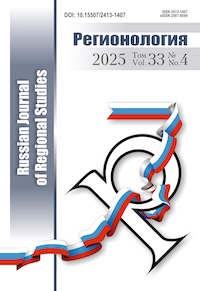M. V. Moroshkina. Spatial Development of Russia: Regional Disproportions
UDK 3 16.334.52
DOI: https://doi.org/10.15507/2413-1407.105.026.201804.638-657
Introduction. The topic of interregional differentiation is relevant due to the existing increase in disproportions in the Russian regions, which has an impact on the development of the state economy. The main objective of the study is to assess the level of interregional differentiation.
Materials and Methods. The study used the indicator of “general entropy”, in particular, the Theil index. The research methodology includes economic and mathematical methods of data processing, statistical data analysis packages, etc.
Results. In the course of the work, the research tasks were set and fulfilled: the development of Russian regions in the period of structural transformations was analyzed; indicators making it possible to assess the level of economic development of territories were provided; a coefficient was chosen, based on the calculation of which the level of interregional differentiation was estimated; the level of interregional differentiation was assessed. It has been proved that the periods of economic growth are characterized by faster rates of development of weak regions due to the state support and redistribution of budgetary funds mitigating territ orial differences. During the periods of economic recession, the state support is provided to the regions with competitive advantages, capable of changing the negative dynamics of the country’s economic development in order to accelerate economic growth.
Discussion and Conclusion. The results achieved can be used when designing the program of development of economic entities or drafting strategic documents. Interregional differences and disparities in most territories determine the dynamics of their development and the opportunities for economic growth, on which the economic policy pursued by the regional authorities should be based. In a competitive environment, the identification and further gaining strength from the advantages of the regions make it possible to form the policy of the region’s development which helps to make management decisions.
Keywords: Russian region, level of regional disparities, gross regional product per capita, Theil index, comparable prices, current prices
Acknowledgments. The study was conducted under the theme No. 0224-2017-0009 “Economic-mathematical modeling and forecasting the adaptation of regional socio-ecological-economic systems to changes in the global economy, changes in federal policy and other external shocks”.
REFERENCES
1. Moroshkina М.V. Differentiation of the regions of Russia based on level of economic development. Studies on Russian Economic Development. 2016; 27(4):441-445. DOI: https://doi.org/10.1134/S1075700716040122
2. Gluschenko K.P. On the issue of application of the Gini coefficient and other inequality indices. Voprosy statistiki = Issues of Statistics. 2016; 2:71-80. Available at: https://voprstat.elpub.ru/jour/article/view/317 (accessed 25.06.2018). (In Russ.)
3. Lavrovskiy B.L., Shiltsin E.A. [Russian regions: convergence or stratification?]. Ehkonomika i matematicheskie metody = Economics and the Mathematical Methods. 2009; 45(2):31-36. Available at: https://elibrary.ru/item.asp?id=11770517 (accessed 25.06.2018). (In Russ.)
4. Granberg A.G., Suslov V.I., Suspitsin S.A. Economic-mathematical studies of multiregional systems. Region: Ehkonomika i Sociologiya = Region: Economics and Sociology. 2008; 2:120-150. Available at: http://recis.ru/region/magazine/30/1578 (accessed 25.06.2018). (In Russ.)
5. Rozanova L.I., Moroshkina M.V., Tishkov S.V. Structural differences in the formation of the gross product in the Russian regions. Trendy i upravlenie = Trends and Management. 2014; 3:293-301. (In Russ.) DOI: https://doi.org/10.7256/2307-9118.2014.3.12694
6. Kolomak E.A. [Interregional disparities in Russia: economic and social aspect]. Prostranstvennaya ehkonomika = Spatial Economics. 2010; 1:26-35. Available at: http://spatial-economics.com/en/2010-year/304-staty-01-2010 (accessed 25.06.2018). (In Russ.)
7. Kolomak E.A. Uneven spatial development in Russia: Explanations of new economic geography. Voprosy ehkonomiki = Issues of Economics. 2013; 2:132-150. Available at: https://elibrary.ru/item.asp?id=18787709 (accessed 25.06.2018). (In Russ.)
8. Krugman P. Space: The final frontier. Prostranstvennaya ehkonomika = Spatial Economics. 2005; 3:121-126. Available at: http://spatial-economics.com/en/archive/2005/18-2005-3 (accessed 25.06.2018).
9. Barro R.J., Sala-i-Martin X. Economic growth. 1995. Available at: https://mitpress.ublish.com/ereader/65/?preview#page/23 (accessed 25.06.2018).
10. Barro R.J., Sala-i-Martin X. Convergence across states and region. Brooking Papers on Economy Activity. 1991; 1:107-158. Available at: https://ideas.repec.org/a/bin/bpeajo/v22y1991i1991-1p107-182.html (accessed 25.06.2018).
11. Voronchikhina E.N. Features and problems of using gross regional product as an integral indicator of economic development. Upravlenie ustojchivym razvitiem = Sustainability Management. 2018; 3(16):5-9. Available at: https://ideas.repec.org/a/bin/bpeajo/v22y1991i1991-1p107-182.html (accessed 25.08.2018). (In Russ.)
12. Kashin V., Nechshadin A. Dynamics of gross regional product of the Russian regions. Obshchestvo i ehkonomika = Society and Economy. 2013; 6:157-170. Available at: https://elibrary.ru/item.asp?id=20132555 (accessed 25.06.2018). (In Russ.)
13. Grigoriev L., Zubarevich N., Urozhayeva Yu. [Scylla and Charybdis of regional policy]. Voprosy ehkonomiki = Issues of Economics. 2008; 2:83-98. Available at: https://elibrary.ru/item.asp?id=9925842 (accessed 25.06.2018). (In Russ.)
14. Ruitenbeek H. Distribution of ecological entitlements: implications for economic security and population movement. Ecological Economics. 1996; 17:49-64. DOI: https://doi.org/10.1016/0921-8009(95)00103-4
15. Stymne S., Jackson T. Intra-generational equity and sustainable welfare: A time series analyses for the UK and Sweden. Ecological Economics. 2000; 33:219-236. Available at: https://pdfs.semanticscholar.org/fc6b/9429e612be40b68a7d8f6b02567dff7aa0... (accessed 25.06.2018).
16. Maslikhina V.Yu. Regional disparities in the Russian Federation. Nauchnyj zhurnal KubGАU = Scientific Journal of KubSAU. 2012; 84(10):1-12. Available at: http://ej.kubagro.ru/2012/10/pdf/22.pdf (accessed 25.06.2018). (In Russ.)
17. Moroshkina M.V. Territorial differentiation of incomes adjusted for inflation. Аktualnye problemy ehkonomiki i prava = Actual Problems of Economics and Law. 2017; 11(2):48-66. (In Russ.) DOI: https://doi.org/10.21202/1993-047X.11.2017.2.48-66
Submitted 27.06.2018; accepted for publication 04.08.2018; published online 28.12.2018.
About the author:
Marina V. Moroshkinа, Research Officer, Department of Modeling and Prognostication, Karelian Research Centre, Russian Academy of Sciences (11 Pushkinskaya St., Petrozavodsk 185910, Russia), Ph. D. (Economics), ORCID: http://orcid.org/0000-0001-6520-4248, Researcher ID: http://www.researcherid.com/rid/O-9248-2015, maribel74@mail.ru
For citation:
Moroshkinа M.V. Spatial Development of Russia: Regional Disproportions. Regionologiya = Regionology. 2018; 26(4):638-657. DOI: https://doi.org/10.15507/2413-1407.105.026.201804.638-657
The author has read and approved the final version of the manuscript.

All the materials of the "REGIONOLOGY" journal are available under Creative Commons «Attribution» 4.0
















